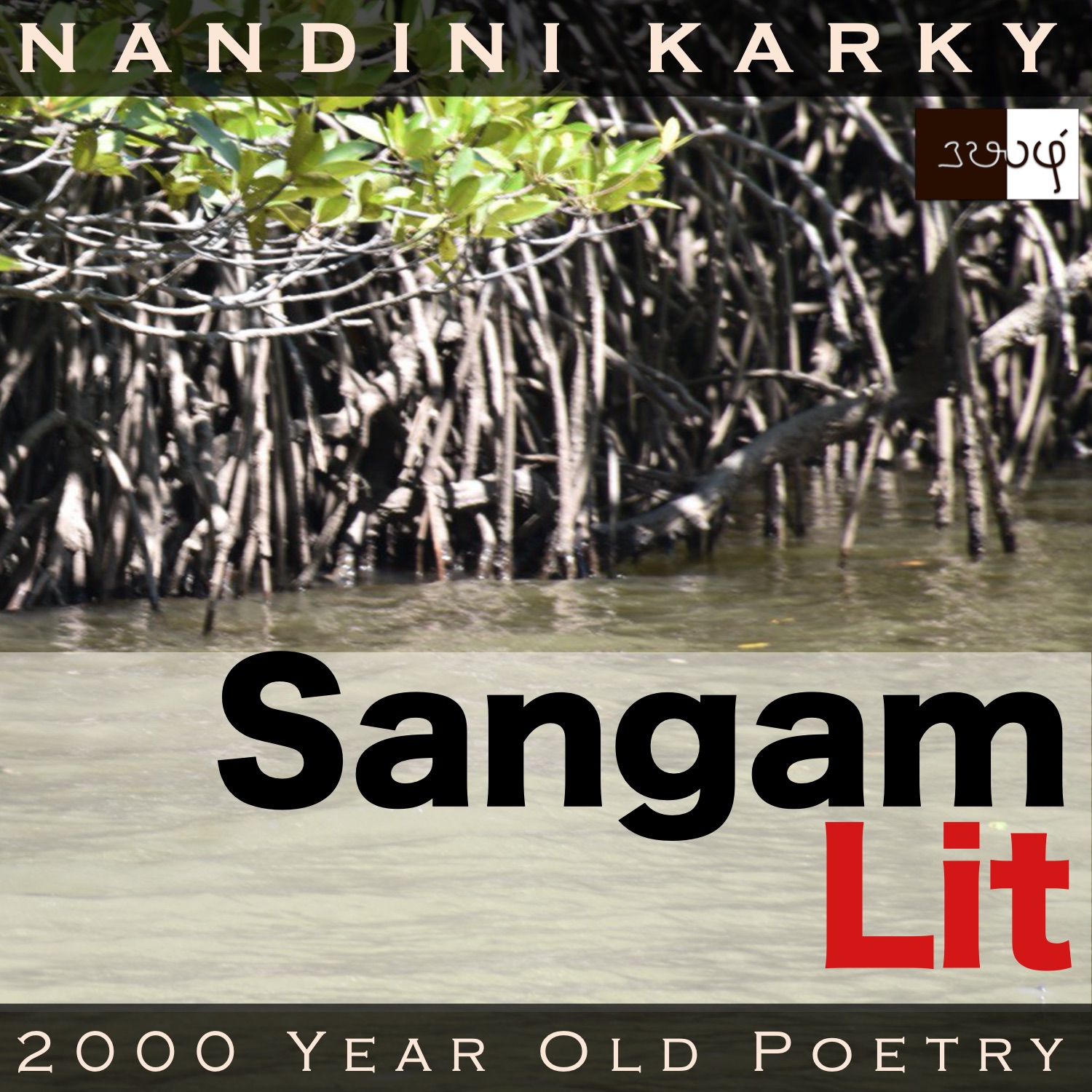Podcast: Play in new window | Download
Subscribe: Apple Podcasts | Spotify | Amazon Music | Android | iHeartRadio | TuneIn | RSS | More

In this episode, we visit a seaside hamlet and perceive scenes from inner and outer life, as depicted in Sangam Literary work, Natrinai 207, penned by an anonymous poet. The verse is set in the coastal regions of ‘Neythal’ and speaks in the voice of the confidante to the foster-mother, declaring the truth of the lady’s relationship with the man, as the danger of marriage to a stranger looms ahead.
கண்டல் வேலிக் கழி சூழ் படப்பை
முண்டகம் வேய்ந்த குறியிறைக் குரம்பைக்
கொழு மீன் கொள்பவர் பாக்கம் கல்லென,
நெடுந் தேர் பண்ணி வரல் ஆனாதே;
குன்றத்து அன்ன குவவு மணல் நீந்தி
வந்தனர், பெயர்வர்கொல் தாமே? அல்கல்,
இளையரும் முதியரும் கிளையுடன் குழீஇ,
கோட் சுறா எறிந்தென, சுருங்கிய நரம்பின்
முடி முதிர் பரதவர் மட மொழிக் குறுமகள்,
வலையும் தூண்டிலும் பற்றி, பெருங் கால்
திரை எழு பௌவம் முன்னிய
கொலை வெஞ் சிறாஅர் பாற்பட்டனளே.
The poem opens with an oft-repeated phrase in songs from the shore – ‘கண்டல் வேலி’ meaning ‘a mangrove fence’, which we will explore soon. ‘முண்டகம்’ is another plant called as ‘Neer mulli’ or ‘water thorn’ and is apparently used in the thatched roofs of huts or ‘குரம்பை’. That the life of these folk revolves around fish is captured by the phrase ‘கொழு மீன் கொள்பவர்’ meaning ‘the hunter of fatty fish’. Without any knowhow of ‘omega-3 healthy fats’ or the benefits of ‘good cholesterol’, the ancients have been calling the fish ‘fatty’, two thousand years earlier. Goes to show names and facts come later but the essence is always felt! The phrase ‘இளையரும் முதியரும் கிளையுடன் குழீஇ’ echoes with a strong bond of comradeship for it means ‘the young and old join together with kith and kin’. Wonder what they do after getting together? The answer appears in the words ‘சுருங்கிய நரம்பின் முடி முதிர்’ meaning ‘untying the knots in the crushed nerve-like fibres of the net’. When we see the words ‘பெருங் கால் திரை எழு பௌவம்’, we understand how the seas appeared, for it means ‘the ocean where waves rise to the sway of huge winds’. What better way to capture the monsoon moods of the Indian seas? Let’s hop off our little boats and step into the shore to understand the story in this verse!
The man and lady have been in a love relationship and the man has been trysting with the lady by night. However, the lady’s parents start to receive queries from strangers about their daughter and the possibility of marriage. Knowing this, the confidante decides to reveal the truth of the lady’s relationship with the man. To do this, she goes to her mother, also the foster-mother of the lady, and says, “The hamlet, where hunters of fatty fish live, is filled with narrow-roofed huts with a backyard surrounded by marshes and fenced by mangroves. This hamlet resounds with uproar, hearing the wide chariot that arrives without fail. Traversing those mountain-like heaps of sand, he comes. Is it even possible that he will return empty-handed? At night, youngsters and older people come together in groups to mend the nets, crushed when thrown on those killer sharks. She’s the innocent-tongued young girl of a fisherman, who will only be captured by the youth of the fishing village, who set forth with a desire to kill, bearing nets and rods, in the wave-filled seas swayed by huge winds.” With these words, the confidante is adhering to the ancient custom of ‘standing for justice’, wherein there was a dictum that the lady should marry the one who has won her heart and not be forced into a marriage to a stranger.
Now, let’s explore the nuances in this song! The confidante opens her statement by talking about the hamlet fenced by mangrove trees. This talks about the intelligent township planning of those seaside villages. The basic nature of mangrove trees is to arrest the intensity of waves, as witnessed by the coastal catastrophes in recent times, because of the destruction of such mangrove forests. The Sangam people have befriended nature and situated their little huts amidst the protection of the mangrove trees. So, no matter how furiously the sea rises, the mangrove fences would protect these seaside dwellers akin to a mother’s womb. Travelling further into the verse, the confidante talks about how the whole village of fisherfolk is in uproar about the chariot that keeps visiting the lady. The confidante then praises the one who comes on this chariot saying he climbs on mountain-like sand dunes to seek the company of the lady, hinting that he is not one to be stopped by impediments on his path. Then she adds that this lord does not seem like one who will return empty-handed. But, if the lady’s parents continue on this path of accepting proposals from strangers, then the confidante says that the lady will only be captured by the nets of fishing youth, who traverse the seas with a desire to kill. With these words, she is making it evident that the lady will end her life in the seas unless her mother and father give up their thought to marry her off to someone else. It could also be that the confidante was saying these words, while the man listens nearby, thus urging him to come seek the lady’s hand in marriage.
With images from the shore, the poem sketches for us the inner life of the lady, wherein she is sworn to the man who trysts with her. She considers her union with him as integral to her very life. While it’s rare for the lady or the confidante to openly declare the relationship with the man to the parents, they resort to that course of action if circumstances seem to put the lady in this danger of a marriage to a stranger. A poem that tells us that the ancients considered the link between love and marriage as something that was not to be taken lightly!




Share your thoughts...